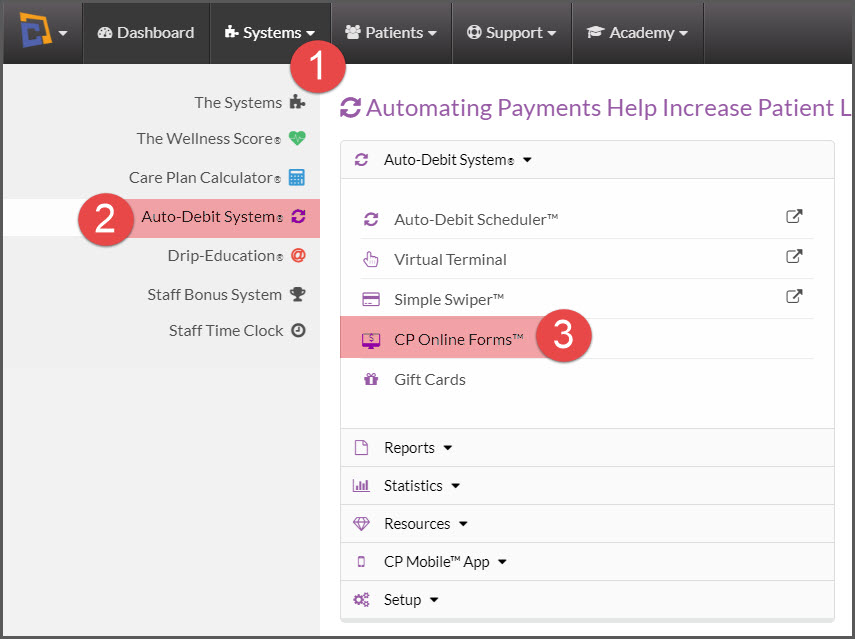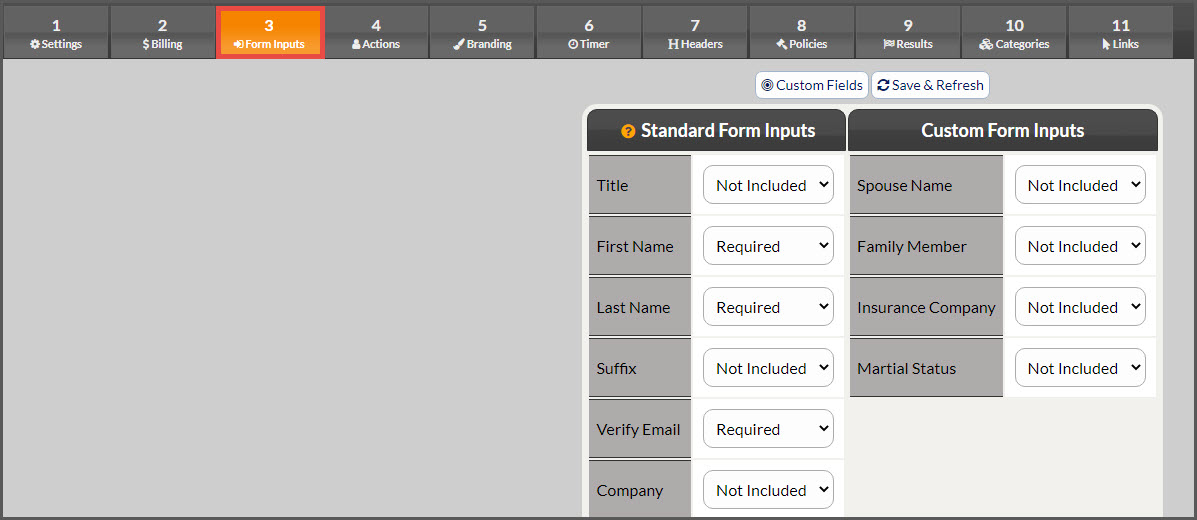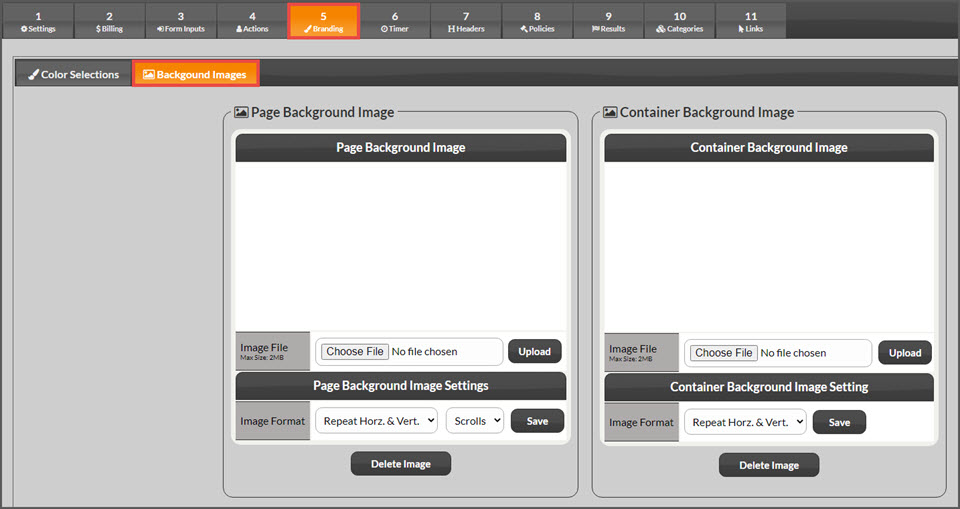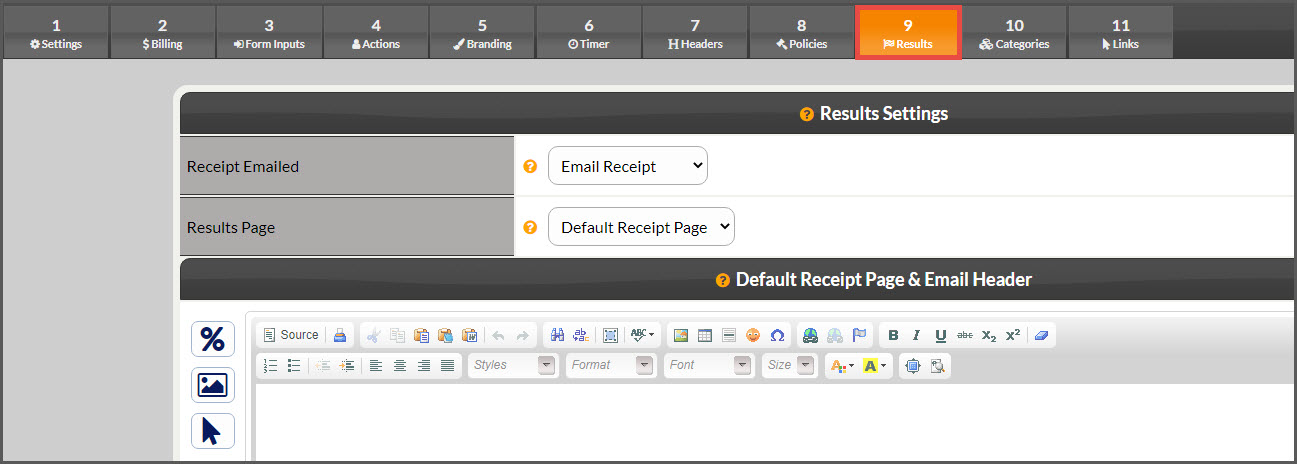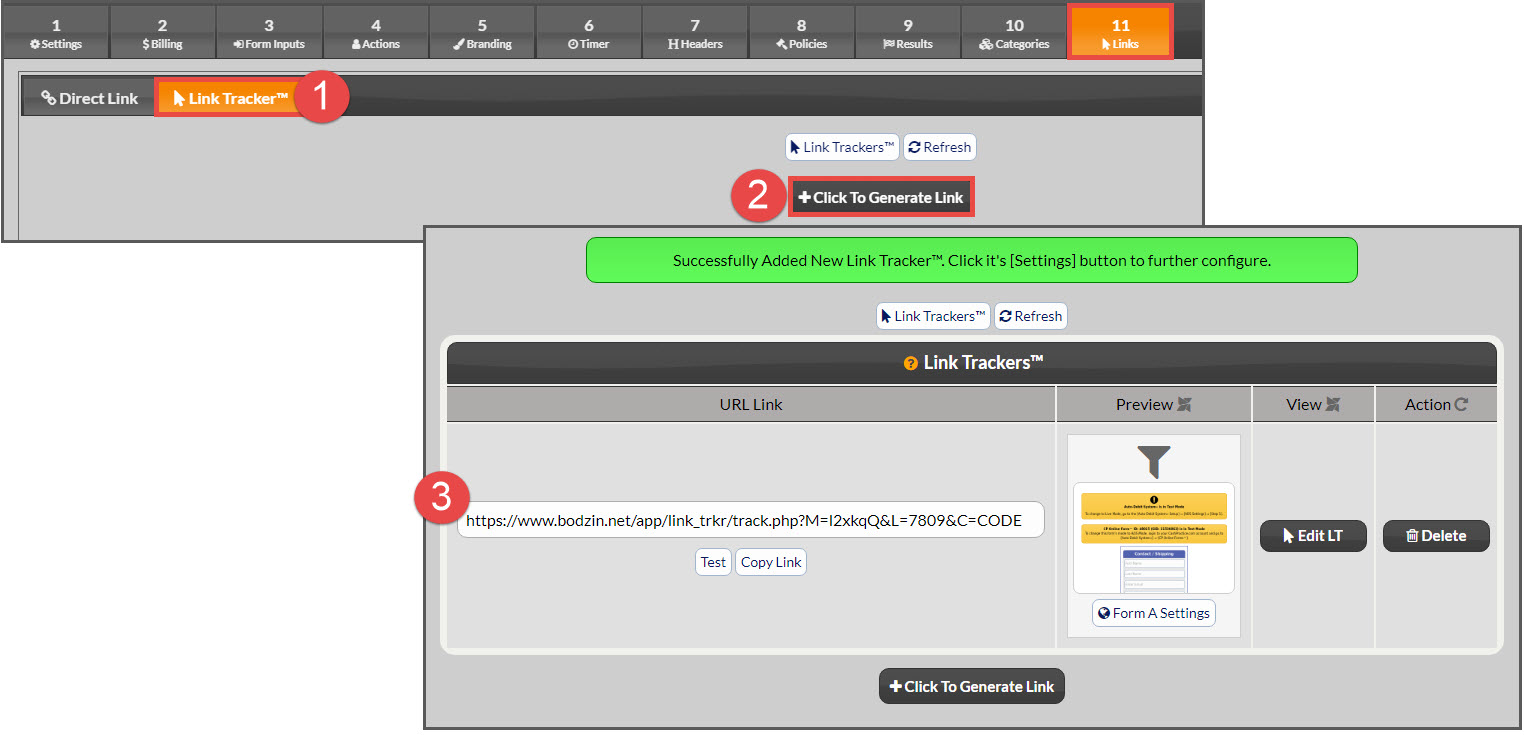Click the Self Help button to use the Cash Practice® walkthrough when logged into your account
Step A: from the [Systems] menu→ [Auto-Debit System®] menu → [CP Online Forms™].
Step B: Click on the [+Add New CP Online Form™] button. Click [OK].
Step C: The page will reload with a new form that now needs to be customized. Click on the [Actions] drop-down and select [Edit Form]to start customizing the form.
Step D: Customize the form
Step 1: Form Settings
- Form Name: You can create your own Custom From Inputs to capture additional data. To create Custom Fields click the [Custom Fields] button from Name: Enter a name for the CP Online Form™ using characters A-Z, a-z, 0-9. Choose a name that identifies the CP Online Form™ so it can be easily found when you have a large list of forms.
- Form Description: Enter a description for the CP Online Form™. What you enter here will be displayed on the CP Online Form™ and Email Receipt as well as substituted for the Drip-Ed™ Variable %FormDesc%. Ex: Monthly Website Membership. If left blank, no description will be displayed.
- Form Settings:
- Form Type:
- Lead Generation Landing Page Form (DES): Select to create Landing Pages. Using the Drip-Education System to assign email campaigns makes this a powerful tool for generating leads online.
-
Static Display Landing Page (DES): No information is collected at all. Use this choice to display the page only. Great if you want to create a custom thank you page.
-
Credit Card & Bank EFT Payment Form (ADS): Uses the Auto-Debit System® to offer both credit/debit and bank EFT payment choices on your form.
-
Credit Card Payment Form (ADS): Uses the Auto-Debit System® to offer credit/debit payments only. This is recommended if you are selling a physical product.
-
Bank EFT Payment Form (ADS): Uses the Auto-Debit System® to offer bank EFT payments only. If you are selling a physical product, we recommend you wait at least one week before shipping it to ensure the EFT does not get returned for insufficient funds.
-
Payment Choices Offered Used With the CP Online Form™ can be set up and used in several different ways.
-
Set Payment Amount - Use this setting if you want to define the payment parameters, such as the amount to charge, schedule a recurring auto-debit, or let the customer select the number of units to pay for.
-
Custom Payment Amount or Schedule- Use this setting if you either want the customer to be able to input an arbitrary $ amount or if you want to set the amount to pay. If you need to define more than just the amount, such as let the customer schedule their own auto-debit through this form, click HERE for more details.
- Returning Patient Login: When a customer completes a CP Online Form™, their information will be stored in a Patient Record.
- No Login Required - If the customer uses the same email address each time they complete a CP Online Form™, their patient record will be updated without creating a new patient record. Otherwise, a New Patient Record will be created.
-
Show Login Button- Verify CP Customer ID - Use this setting if you want a Returning Customer to LOG IN (using their Customer ID) so that the CP Online Form™ gets pre-populated with their Patient Record data. They log in with a CP Customer ID (which is included in the receipt that gets emailed to them) and their email address. You can locate their Customer ID in the Patient Record as well.
-
Show Login Button- Verify TPS ID - Use this setting if you want a Returning Customer to LOG IN (using their TPS ID) so that the CP Online Form™ gets pre-populated with their Patient Record data. They log in with their TPS and their email address.
- Form Mode
-
Test Mode: Uses a test merchant account and requires the use of test credit card numbers (see Auto-Debit System® Quick Start Guide for test card numbers.)
-
ADS-Mode: This is the current mode you have the Auto-Debit System® set to either ADS-Mode: Test (uses test merchant account) or ADS-Mode: Live (use your active merchant account).
-
- Form Submit Button: Enter what you want the CP Online Form™ to Submit button to say. For example, 'Subscribe Now' or 'Click To Pay'.
- Status:
- Active: Turns ON the CP Online Form™.
- Inactive: Turns OFF the CP Online Form™. If you try to access the CP Online Form™ while it's Inactive, you will be redirected to an error page.
Step 2: Billing
Auto-Debit System® Settings:
- Assign Transaction To Auto-Debit Group: Select the Auto-Debit Group™ you want the transaction assigned to. This is optional.
Recurring Payment Settings: Options below will only display if you are offering [payment choices] with [user-defined billing] settings.
- Initial Payment Amount: Enter the $ amount you want to immediately charge the customer. If you leave blank or enter 0, the CP Online Form™ will skip the initial charge.
- Auto-Debit Frequency (option): Select the Frequency of the recurring auto-debit. The first auto-debit payment will be "that" long from the date the customer completes the CP Online Form™.
- Auto-Debit Amount: Enter the $ amount for the auto-debit. If a frequency is selected and you leave this field blank, the Initial Fee will be used for the auto-debit amount.
- Number of Auto-Debit Payments: Either enter the number of auto-debits to recur or check the box for the payments to recur indefinitely.
Multi-Item Quantity Settings:
- Include Quantity Selector: Do you want the CP Online Form™ to offer the customer the ability to purchase more than one? Select Yes or No. The options below will only display if you select "yes".
- Quantity Label: Enter the Label you would like for your quantity selector. For example, if you are selling memberships, you could enter "Total Memberships" or "Number of Memberships". If you are selling a product, you could say "Quantity".
- Quantity Minumum: Enter the minimum quantity a customer can order with this CP Online Form™.
- Quantity Maximum: Enter the maximum quantity a customer can order with this CP Online Form™.
- Quantity Multiplier Value: Enter the Quantity Multiplier Value you wish to use. For example, if you want to increase the price by 15% for each quantity selected, enter 0.15. The default value is 1, which increases the price by 100% for each increment.
- Apply Quantity Multiplier To: When a customer selects a quantity, the CP Online Form™ will multiply the fees by the quantity. Do you want to multiply Only the Initial Fee, Only the Auto-Debit Fee, or Both of them?
Step 3: Form Inputs
Form inputs allow you to select what information is collected when processing the online form. Select your form Inputs from the list of standard inputs and custom inputs.
- Not Included - Input will not be included in the CP Online Form™
- Included - Input will be included on the CP Online Form™ and will be Optional.
- Required - Input will be included in the CP Online Form™ and Required.
Step 4: Actions
Patient Assignment Settings
- Assign Patient To Provider: You can create your own Custom From Inputs to capture additional data. To create Custom Fields click the [Custom Fields] button and select the member you want the customer assigned to. If you select an associate member to assign the customer to, their account must remain active for the CP Online Form™ to function.
- Assign Patient To Label (success): Select the Label you want to be assigned to the customer if the transaction is successful.
- Assign Patient To Label (failure): Select the Label you want to be assigned to the customer if the transaction fails.
- Assign Patient To Group (success): Select the Group you want the patient assigned to if the transaction is successful. This is optional.
- Assign Patient To Group (failure) Select the Group you want the patient assigned to if the transaction fails. This is optional.
Drip-Education® Campaigns
- Assign Patient To Campaign (Success): Select the Drip-Ed™ Campaign you want to be assigned to the customer if the transaction is successful. This is optional.
- Assign Patient To Campaign (Failure): Select the Drip-Ed™ Campaign you want to be assigned to the customer if the transaction fails. This is optional.
Step 5: Branding
- Color Selection: The form comes defaulted to a generic color scheme, choose to Customize any part of the form colors or leave as-is.
- Background Images: You have the option to upload your own background or container image. Choose the file and select the correct settings.
Step 6: Timer

Countdown Timer Settings: (Optional) Customize a Countdown timer to display on your form. The Countdown Timer is a great way to create urgency so people take action.
- Set the Timer Expires date and time.
- Customize the colors of the timer or leave as-is.
- You will use the %CountDownTimer% variable created in step 5 and insert the %CountDownTimer% variable into the header of your form on step 6.

- Header: The CP Online Form™ Header can be customized with whatever info you want. This is where you may give instructions, descriptions, thank you, etc. so the customer knows what they should do.
- For the most professional look, it is suggested that you create a Header Image File (png, gif, or jpg) and upload it using the Insert/Edit Image button in the editor. Using the same header image on both the CP Online Form™ Receipt and Header is a good technique for a professional look. If you leave it blank, no header will be displayed.
- Footer: The CP Online Form™ Footer can be customized with whatever info you want. The footer is typically where you would place your company guarantees, return/cancellation policies, etc.
- If you do use a link, be sure to instruct the link to open in a new window so the customer does not leave the form when they click it. Like the header, you can use an image file or leave it blank.
Step 8: Policies
- Privacy Policy: The CP Online Form™ Privacy Policy is where you indicate your company's Privacy Policy. The link Privacy Policy will be placed at the bottom of the CP Online Forms™ and will open a pop-up window. Here enter your policies, or at a minimum, use the pre-loaded content and delete the text in red font confirming you've read and agreed.
- Terms Of Use: The CP Online Form™ Terms of Use is where you indicate your company's Terms of Use. The link Terms of Use will be placed at the bottom of the CP Online Forms™ and will open a pop-up window. Your merchant provider REQUIRES this link on ALL online forms. Here enter your Terms of Use, or at a minimum, use the pre-loaded content and delete the text in red font confirming you've read and agreed.
- Return Policy: The CP Online Form™ Return Policy is where you indicate your company's Return Policy. The link Return Policy will be placed at the bottom of the gateway and will open a pop-up window. Your merchant provider REQUIRES this link on ALL online forms. Here enter your Return Policy and remove the red font confirming you've read and agreed.
Step 9: Results
Once the customer submits the CP Online Form™, it will return a result. In most circumstances you want the customer to be redirected to a "receipt" or "thank you" page. However, you may have the need to redirect the results to your own page/script. For example, if you have a script that creates a new member account on your own website, you would want to redirect to that URL.
Besides sending the customer to a results page, the CP Online Form™ can email them a receipt. Use the two editors below to customize both the Default Receipt Page and the Email Receipt Header and Footer.
- Default Receipt - Once a customer submits the form, they will be redirected to the Default Receipt Page.
- Custom Results Page - Select this option if you need to redirect a customer to another page or script. Enter the CP Online Form™ Custom Results URL. If you are using a custom URL, you will need to download the Auto-Debit System® API Manual for a list of result variables that can be passed to the custom URL. If you are not sure what to do, leave by DEFAULT.
Step 10: Assigned Categories:
Use the Categories to organize your Online forms, Drip-Ed Campaigns™ and Link Trackers™.
Step 11: Links
- Direct Link: This is the link to this CP Online Form™. You can click it to open the CP Online Form™ in a new browser tab. In the ULR, the FID can be changed to any 3-Digit code. This is used to identify where you place the link. For example, if you place the link on your website, on Facebook, and on google ads, use a unique 3-digit code for each so you can see where the link was clicked when looking at your stats.
- Link tracker: The Drip-Ed Link Trackers™ allows you to better track your stats. By assigning this CP Online Form™ to a Drip-Ed Link Tracker™ you will be able to see who clicks the links and more. Then use its Drip-Ed™ Variable in your email campaigns as links to the form.
- To generate a tracker, access the [+ Click to Generate Link] button.


